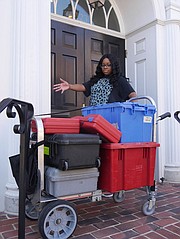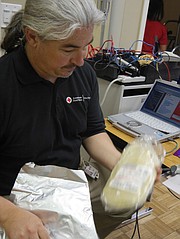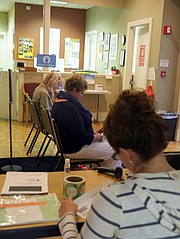It was 12:20 p.m., and donors were starting to line up for the American Cross Blood Drive at Alexandria Chapter House. First scheduled appointment was Lane Stone who "has been giving blood so many years I don't even remember." She said that there are so many things you can't do anything about, like Orlando, but you can give blood.
Garrick Robbins, had walked in at 11 a.m., surveyed the site and figured out how to set up the day's operation. He said, "Each site is different." The driver, Reuben Lindsay, has just arrived from Baltimore with stacked boxes for the day including blood pressure cups, thermometers, blood kits, hemocue for measuring hemoglobin, a radio that will be turned on to relax any donors with misgivings about the needle. It is currently playing, "I'm gonna hold you ...."
Robbins said, "We say you can save three lives with one pint of blood. If we use a certain bag we can get red blood cells, plasma and platelets."
All tables would be set up, blue confidential screens in place, equipment distributed and QC (quality control) on equipment complete by 12:30 p.m. when the doors opened. "It's sort of chaotic for a while." Robbins is team supervisor for the Red Cross Blood Drives in Northern Virginia and the District of Columbia. He says they have 32 appointments on the day's schedule for this site. "We are totally filled. We hope to get 21 units today."
He unfolds the blue screening panels and sets them up explaining, "We want the donors to feel they can answer the health history questions in privacy."
Each patient gets a confidential screening which is a mini-physical to be sure they are qualified to give blood. "You have to be careful who you draw." He said less than half of the U.S. population is eligible to give blood and of those who are eligible, the rejection rates are approximately 16 percent depending on the geographical area.
Ligaya Narbay, one of the new donor specialists on the team, pulls on blue plastic gloves and wipes down the table with an anti-bacterial cloth.
Robbins said, “We get a lot of people who donate for the first time. Part of our job is to comfort them. If they have a good experience the first time, they will donate blood again."
Janaya Patron-Abram, one of the donor specialists, said, "I feel like I use my hospitality skills."
Robbins said, "It's kind of like a mosquito bite prick. It shouldn't be overly painful." He added, "Summer is always a difficult time to maintain the blood supply. People are on vacation, and school is out for the high school and college students who donate. Robbins says that families come in together and make it a family event. "They bond over the experience. And a lot of parents like to be there the first time their child donates." Blood donors are eligible at 17 years of age or 16 with a parent's consent.
"OK, time to distribute ….” The donor specialists ready their stations for the incoming donors. The blood drive will run from 12:30.-6:30 p.m. with the whole process for one person (from check-in to final snack) taking about an hour. It begins with a health history taken by a donor specialist followed by a confidential screening then choosing the appropriate collection set kit. Robbins said, "There is about a 10-week Red Cross training program for the donor specialists with observation in the field. It takes a few months to learn to draw blood. There is a learning curve and at a year they get really good at it."
Qualified donors will move to a padded table where they are usually in a sitting position. Drawing the blood can take from 8 minutes up to 20 minutes. "Some people bleed faster than others." Then on to the cranberry or orange juice and raisin-oatmeal cookies or packages of Cheez-Its.
Robbins was a trained as a medic in the Army and worked at a hospital in ICU when he got out. "Then I was a donor recruiter." But he said, "This job with the Red Cross just sort of fell in my lap. I thought I could make more of an impact in blood collection, make sure people are seen promptly, good customer service, more control." He says people give blood to make a difference. "Some people are passionate about it."


